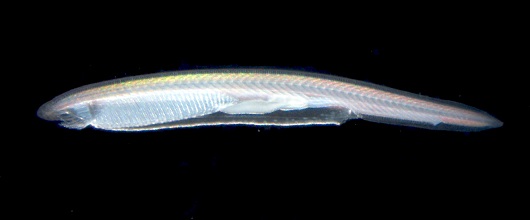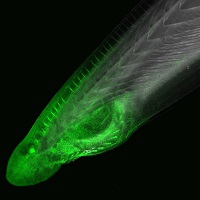Living fossil challenges thinking on brain evolution

An ancient sea creature, discovered off the coast of Scotland in 2011, has shed new light on how evolution formed the modern brain.
An international team involving researchers at the University of St Andrews have examined the amphioxus, also known as the Lancelet, which was thought to be a brainless, faceless fish. Instead, they found it has a very complex brain which confounds previous understanding of how vertebrate brains evolved.
The latest research, carried out by the Universities of St Andrews, Murcia and Barcelona and the Centre for Genomic Regulation, published in PLoS Biology, compared the amphioxus brain with current models of brain development in vertebrates, such as chicks and fish.

The new research casts doubt on the current textbook idea that the complex vertebrate brain evolved from a simple three-part brain composed of forebrain, midbrain and hindbrain. Rather, the new research suggests that the vertebrate brain must originally have formed from two parts.
Dr Ildiko Somorjai of the School of Biology at the University of St Andrews, co-author of the study, said: “Amphioxus is an amazing creature that can tell us a lot about how we have evolved. Humans have enormous brains with a large number of anatomical subdivisions to allow processing of complex information from the environment, as well as behavioural and motor control and language.
“Research in amphioxus tells us that even an outwardly simple brain may have complex regionalisation. It also strengthens the position of amphioxus as an important non-vertebrate model for understanding vertebrate evolution and development, with clear implications for biomedical research.”
 Described as a “brainless, faceless fish”, amphioxus was found off the coast of Orkney during a marine survey in 2011, and is thought to be among the first animals to have evolved a structure similar to a backbone, the notochord.
Described as a “brainless, faceless fish”, amphioxus was found off the coast of Orkney during a marine survey in 2011, and is thought to be among the first animals to have evolved a structure similar to a backbone, the notochord.
Despite its appearance, amphioxus is not a fish. It has a primitive spinal cord which runs down its back, but no clearly defined face, no bones or jaws and a small brain with a single light-sensing “frontal eye”. It has changed so little for hundreds of millions of years that it has been described as a “living fossil”.
As the best living proxy for the vertebrate ancestor, amphioxus gives important insight into what humanity’s distant ancestor looked like, and how it might have behaved.
Image captions
Top: Small adult amphioxus © Dr Ildiko Somorjai
Middle: Amphioxus and vertebrate brains are anatomically different, but share a basic blueprint © Dr Ildiko Somorjai
Bottom and news thumbnail: Amphioxus head as seen under a fluorescence microscope © Dr Ildiko Somorjai
Background information
The research was jointly led by José Luis Ferran and Luis Puelles of the Department of Human Anatomy and Psychobiology of the University of Murcia; Manuel Irimia of the Centre for Genomic Regulation (CRG) in Barcelona; and Jordi García Fernández of the Genetics Department of the University of Barcelona, Spain.
Albuixech-Crespo et al. (2017) ‘Molecular regionalization of the developing amphioxus neural tube challenges major partitions of the vertebrate brain’. PLoS Biol 15(4): e2001573. DOI
Issued by the University of St Andrews Communications Office, contactable on 01334 467310 or [email protected].
Category Research